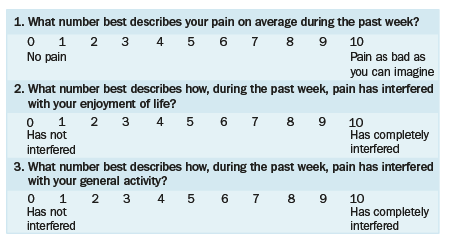Monitoring chronic pain outcomes
Chronic pain outcomes should be monitored regularly, usually on a monthly basis at each clinic visit. The individual management plan and management goals should be reviewed to monitor progress.
Chronic pain should be monitored using multidimensional assessment tools and simple physical tests. It is important to monitor function and quality of life, in addition to patient-reported pain severity. A 30% improvement in pain severity reflects a clinically important change for most patients. However, reduced patient-reported pain severity alone does not indicate progress.
In adults, repeated measurement of the PEG scale and timing five ‘sit-to-stand’ tests at each review appointment is an efficient way to monitor patient progress.
- The PEG scale measures Pain intensity, Enjoyment of life and General activity on numerical rating scales.
- Timed ‘sit-to-stand’ tests determine the time it takes for a patient to move from sitting to standing from a standard chair without using their arms for support. Taking longer than 15 seconds for five ‘sit-to-stand’ tests indicates they have a significant falls risk and the need for a strength program.
In children, the most important measures of progress are school attendance and participation in physical activities with peers (eg casual play, physical education, sport). Although the PEG scale has not been validated in children and adolescents, it can be used in older children who are able to use numerical pain scales. For younger children, the Faces Pain Scale-Revised can be used to monitor self-reported pain severity and the parent or carer can complete the PEG scale with or for their child.
If additional detail is required in adolescents or adults, more lengthy questionnaires can be used (eg the Brief Pain Inventory) to monitor factors affecting the pain experience (eg mood, sleep). If additional detail is required in younger children, consider referral to a paediatric chronic pain service.
If a person is using analgesia, always assess the response and need for ongoing therapy; see Reviewing analgesia efficacy for chronic noncancer pain for advice.

